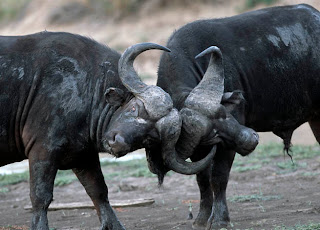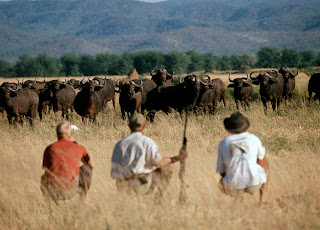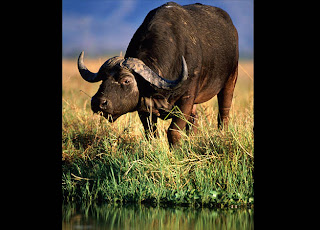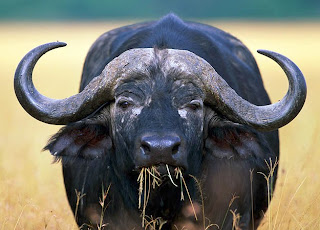Wednesday, July 13, 2011
Tuesday, July 12, 2011
African Grey Parrot
Category: Birds
Phylum: Chordata
Class: Aves
Order: Psittaciformes
Family: Psittacidae
Species: Psittacus erithacus
These amazing birds are extremely intelligent due to their ability to mimic human voices and other sounds. In recent studies, African Grey Parrots have proven to have one of the highest vocabularies of the entire bird species.
The African Grey Parrot resides in West and Central Africa. The females are usually a lighter shade of gray with a slightly dimmer red tail, whereas the males are a deeper gray, with a more vibrant red tail. Though not as colorful as some of its relatives, African grey parrots are a favorite because of their amazing personalities.
As with all pets, if you are interested in obtaining an African Grey Parrot, we strongly recommend that you thoroughly check it out ahead of time. These wonderful creatures require a tremendous commitment. They can be great pets, but do require a lot of work and a lot of love!
Accentor
Category: Birds
Phylum: Chordata
Class: Aves
Order: Passeriformes
Family: Prunellidae
Species: Prunella
Accentors are small, sparrowlike birds founds throughout Europe and Asia. Unline Sparrows, they have slender, finely pointed bills and are more closely related to Thrushes or Warblers.
Accentors usually live in mountainous regions, often well above the tree line. The Alpine Accentor is no exception, one race breeding at altitudes of up to 18,000 ft. (5,500 m). However, most Accentors breed at lower levels, in scrub-type vegetation. The Dunnock is particularly common in woods, hedgerows and gardens. In summer, Accentors feed on insects; in winter, they live almost entirely on seeds and berries.
Worldwide Region(s):
Asia, Europe
Tree frogs
Nature has provided some crafty little defense mechanisms for amphibians to protect themselves against predators. While amphibians may not have special weapons like claws or sharp teeth to defend themselves, they do have slippery, quick moving bodies and a very shy, quiet nature. This may not seem like much of a defense, but don't be fooled. These are beautiful, resiliant creatures that have survived a very long time on this planet
As another form of protection, many amphibians don't show themselves in the light of day. They also have other survival tricks involving an attribute known as Coloration. There are several types:
Flash Coloration
Warning Coloration
Protective Coloration
Flash Coloration is different from Warning Coloration, because it is not seen until the amphibian is under attack. Their bright colors often times distract and confuse predators, thus help the amphibians escape. Changing skin coloration is employed by frogs, toads, and some salamanders.
Predators who attack a brightly colored amphibian quickly learn to avoid similar-looking ones in the future. Protective Coloration is important to many amphibians, a large number of which are green, brown, or gray colors that are common in nature. These color patterns act as camouflage, helping amphibians blend in with their surroundings
Treefrogs and other color-change artists change their colors over time to match the background they rest upon. Some amphibians produce mild skin poisons, and others produce toxic secretions strong enough to kill predators, like the Poison-arrow frog.
As another form of protection, many amphibians don't show themselves in the light of day. They also have other survival tricks involving an attribute known as Coloration. There are several types:
Flash Coloration
Warning Coloration
Protective Coloration
Flash Coloration is different from Warning Coloration, because it is not seen until the amphibian is under attack. Their bright colors often times distract and confuse predators, thus help the amphibians escape. Changing skin coloration is employed by frogs, toads, and some salamanders.
Predators who attack a brightly colored amphibian quickly learn to avoid similar-looking ones in the future. Protective Coloration is important to many amphibians, a large number of which are green, brown, or gray colors that are common in nature. These color patterns act as camouflage, helping amphibians blend in with their surroundings
Treefrogs and other color-change artists change their colors over time to match the background they rest upon. Some amphibians produce mild skin poisons, and others produce toxic secretions strong enough to kill predators, like the Poison-arrow frog.
Amphibians
Like many other animals, Amphibians are vertebrates, which means they are animals with a backbone and an internal skeleton.
Most amphibians live part of their life in water and good portion of it on land. Some breathe through gills, much like a fish does.
It's believed that amphibians might have evolved from a prehistoric type of finned fish around 400 million years ago. Today's amphibians are, of course, very different from their ancestral forms. They still require water due to their non-waterproof skin. While some of these animals can exist on land, many amphibians must return to the water, especially to breed and/or lay eggs
The classification Amphibia represents somewhere around 5,000 species of carnivorous animals, arranged in three distinct groups. These are Frogs and Toads, Newts and Salamanders, and Caecilians.
A Caecilian - a small slender, limbless, wormlike, amphibian, belonging to the Gymnophiona order. Caecilians are a burrowing creature that live mainly in moist soil in tropical regions
Sadly, amphibians are prey for many other animals - birds, mammals, reptiles, fishes, and even other amphibians rely upon these animals as their food source. Amphibians are a fundamental part of the Great Food Chain of Life. In order for life to balance itself out, some animals must be sacrificed so that others may live. Yet amazingly, amphibians have managed to survive for millions of years.
Imitating poisonous species can definitely help keep Salamanders alive, although certain salamanders actually have poison within their tails (the most vulnerable part of their bodies open to attacks). Some of these smart critters rely on the old trick of "playing dead," while others protect themselves by biting.
These incredible little animals can even scream and yelp! One unusual defense is the ability to survive inside the stomach of a predator! In a few cases, some amphibians have been noted to live as long as 30 minutes inside a predator's stomach! This might be "hard to swallow," but it's true. Believe it or not!
Most amphibians live part of their life in water and good portion of it on land. Some breathe through gills, much like a fish does.
It's believed that amphibians might have evolved from a prehistoric type of finned fish around 400 million years ago. Today's amphibians are, of course, very different from their ancestral forms. They still require water due to their non-waterproof skin. While some of these animals can exist on land, many amphibians must return to the water, especially to breed and/or lay eggs
The classification Amphibia represents somewhere around 5,000 species of carnivorous animals, arranged in three distinct groups. These are Frogs and Toads, Newts and Salamanders, and Caecilians.
A Caecilian - a small slender, limbless, wormlike, amphibian, belonging to the Gymnophiona order. Caecilians are a burrowing creature that live mainly in moist soil in tropical regions
Sadly, amphibians are prey for many other animals - birds, mammals, reptiles, fishes, and even other amphibians rely upon these animals as their food source. Amphibians are a fundamental part of the Great Food Chain of Life. In order for life to balance itself out, some animals must be sacrificed so that others may live. Yet amazingly, amphibians have managed to survive for millions of years.
Imitating poisonous species can definitely help keep Salamanders alive, although certain salamanders actually have poison within their tails (the most vulnerable part of their bodies open to attacks). Some of these smart critters rely on the old trick of "playing dead," while others protect themselves by biting.
These incredible little animals can even scream and yelp! One unusual defense is the ability to survive inside the stomach of a predator! In a few cases, some amphibians have been noted to live as long as 30 minutes inside a predator's stomach! This might be "hard to swallow," but it's true. Believe it or not!
Elephant photos
An African elephant (Loxodonta africana) orphan checking an adult's mouth for coconut meal in Tsavo East National Park, Kenya
Encounter between African elephants (Loxodonta africana) and an African lion (Panthero leo) in Masai Mara, Kenya.
An African lion (Panthera leo) eating an African elephant calf (Loxodonta Africana) carcass in Hwange National Park, Zimbabwe.
CAPE BUFFALO PHOTO GALLERY
As one of the "Big Five" game animals, the cowlike Cape buffalo have heavy, ridged horns and massive builds, weighing up to 1,500 pounds and standing 65 inches tall at the shoulder.
Females and their young generally make up the majority of a herd while male buffaloes live in bachelor groups. When in danger, a young calf will bellow for its herd, which will defend it.
The Cape buffalo is known as one of the "Big Five" game animals along with leopards, lions, rhinos and elephants. The name comes from hunters who wanted these large animals for trophies
Cape buffalo are very social animals and live in herds of a few hundred. However, the buffaloes are non-territorial and have been known to live in mixed herds up to 1,500 animals, especially in the Serengeti.
Females and their young generally make up the majority of a herd while male buffaloes live in bachelor groups. When in danger, a young calf will bellow for its herd, which will defend it.
The Cape buffalo is known as one of the "Big Five" game animals along with leopards, lions, rhinos and elephants. The name comes from hunters who wanted these large animals for trophies
Cape buffalo are very social animals and live in herds of a few hundred. However, the buffaloes are non-territorial and have been known to live in mixed herds up to 1,500 animals, especially in the Serengeti.
Cape buffalo photos
Cape buffalo live in the savannah woodlands and plains, and are never more than one day's walk from a water source.
Cape buffalo vary in color, usually dark brown or black, although the females tend to be lighter than the males. Color, horn size and horn shape are distinctions that can identify young buffaloes from old, and males from females.
Cape buffalo are herbivores and depend on grass as their dietary staple. Because the buffaloes do not have many predators, the availability of grass regulates the buffalo population more than anything else.
Humans are the Cape buffalo's biggest threat. A herd of Cape buffalo can become extremely dangerous when threatened
Although they do not have many natural enemies, Cape buffalo are capable of defending themselves against lions.
Cape buffalo vary in color, usually dark brown or black, although the females tend to be lighter than the males. Color, horn size and horn shape are distinctions that can identify young buffaloes from old, and males from females.
Cape buffalo are herbivores and depend on grass as their dietary staple. Because the buffaloes do not have many predators, the availability of grass regulates the buffalo population more than anything else.
Humans are the Cape buffalo's biggest threat. A herd of Cape buffalo can become extremely dangerous when threatened
Although they do not have many natural enemies, Cape buffalo are capable of defending themselves against lions.
CAPE BUFFALO PHOTO GALLERY
As one of the "Big Five" game animals, the cowlike Cape buffalo have heavy, ridged horns and massive builds, weighing up to 1,500 pounds and standing 65 inches tall at the shoulder.
Females and their young generally make up the majority of a herd while male buffaloes live in bachelor groups. When in danger, a young calf will bellow for its herd, which will defend it.
Dog Ear problems
Ear problems most commonly come in the form of bacterial or fungal infections, mites, fleas, or foreign objects (foxtails, dirt, etc.) lodged in the ear canal. Some other common problems include hematoma of the earflap and tumors of the inner ear.
Mullein flower, Oregon grape, garlic, marshmallow, ginkgo, and yarrow are especially well suited for treating infections and parasite infestations of the ear. Mullein flower, garlic and Oregon grape are all strong antimicrobials with strong affinities toward inhibition of mites and various pathogens that may cause ear problems.
The slippery oily mucilage of marshmallow root provides soothing relief and a protective, antimicrobial barrier on inflamed tissues of the outer ear. Yarrow is especially useful for treating small hematomas of the earflap. Used externally, the oil helps strengthen exterior capillary walls, while internal doses of yarrow and ginkgo tea or tincture improve capillary circulation and internal tonicity. Witch hazel may also be effective for external treatment of earflap hematomas, as its strong astringency quickly constricts weak or inflamed blood vessels
Solutions
Combine equal amounts of the following oil infusions:
Mullein flower
Oregon grape
Garlic
Marshmallow
You can add 1020 drops of vitamin E oil to this mixture to act as a preservative and aid in skin healing. For ear mites or infections of fungal or bacterial origin, 612 drops of the oil can be applied to affected areas of the earflap or ear canal. A soft plastic dropper is best for application into the ear canal, while a piece of soft cotton, gauze, or even clean fingertips will suffice as an external applicator
Subscribe to:
Posts (Atom)

















































